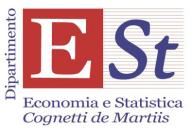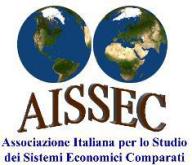Edited by Luca Bortolotti and Marta Marson, University of Turin and OEET
The XXII Italian Association for the Study of Comparative Economic Systems (AISSEC) Scientific Conference held in Pescara in June 2022 collected several contributions on the topic “(Re)discovering the drivers of economic development”. This newsletter contains three articles based on a selection of the contributions focusing on gender inequality.
The challenges faced by women in their multiple roles is indeed an unescapable issue to be addressed to guarantee the achievement of Sustainable Development Goal #5 (Gender Equality). The effect of discrimination is multidimensional, involving employment, health, education, safety, and with positive, i.e. self-reinforcing, feedback mechanisms across dimensions. The articles selected in this newsletter describe gender issues from different perspectives and through different methodologies. They also converge in indicating the fight against gender discrimination and women empowerment are still crucial issues to be addressed for economic and human development.
Newsletter n. 22 | September 2022 - Download PDF
The first article in this newsletter is by Elisabetta Calabresi and investigates the effect of female education on the prevalence of Intimate Partner Violence (IPV) in Uganda and the channels underlying this effect. The author adopts a local randomization approach to a fuzzy Regression Discontinuity Design, exploiting the implementation of the Universal Primary Education policy in 1997. An additional year of schooling decreases the physical IPV index. On the contrary, there are no effects on women’s gender attitudes, labor market outcomes, and relationship characteristics. The results suggest that the relationship between female education and IPV is context-dependent and that female education may help, but it is not sufficient, for achieving real gender equality.
The second article is by Federica Alfani, Fabio Clementi, Michele Fabiani, Vasco Molini and Enzo Valentini. Drawing on various macro- and micro-data sources, the authors present robust evidence of an inverted U-shaped relationship between female labor force participation and inequality. A decile-level analysis shows that female labor force participation has higher levels of returns on income among top deciles of the income distribution compared with the lower deciles in the developing countries analyzed. This evidence focuses attention on the importance of developing policies specifically targeting women in lower deciles of the income distribution.
The last article, by Emanuela Ghignoni, Marilena Giannetti and Vincenzo Salvucci, reminds us that gender discrimination in the labor market is not a problem only for developing countries and emerging economies which might still suffer from cultural norms preventing the full development of women potential. This article explores the extent and evolution of wage gaps in Italy by gender and citizenship. Indeed, wage gaps between migrant and native workers are also registered. Micro-data from the Italian labor force survey are analyzed with decomposition techniques to estimate that part of the wage gap that cannot be explained by differences in worker’s characteristics and is explained by the discrimination of migrants and migrant women.









